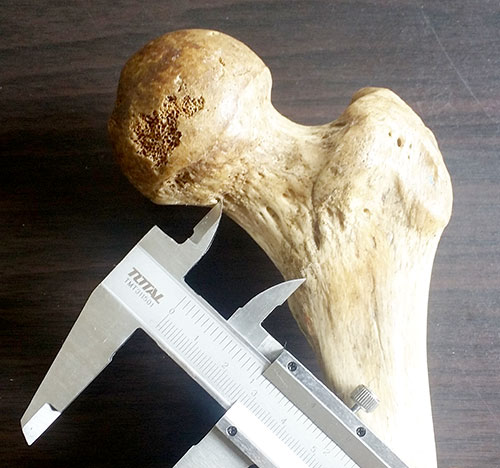Bicondylar Angle and its Relation with Length and Neck Length of Human Femur
Keywords:
bicondylar angle, femoral condyles, femoral length, femoral neckAbstract
Introduction: Femoral bicondylar angle has immense importance from anatomical and clinical (forensic and anthropometric) point of view and is the characteristic feature of bipedal gait in humans. It is the angle between axis of femoral shaft and a line perpendicular to its transcondylar axis. The study was carried out to assess bicondylar angle and its relationship with femur length and neck length.
Methods: Bicondylar angle, length, and neck length of available dry human femurs of unknown sex and age were measured using osteometric board and vernier caliper. Bicondylar angle between two sides were compared. Similarly, relation between the angle and femoral length and length of femoral neck was studied.
Result: Bicondylar angle on right side was 8.65° (SD = 2.03) and on left side was 9.35° (SD = 2.05) and the different was not statistically significant (p = 0.08). On both sides, no significant correlation was found between bicondylar angle with femoral length and length of femoral neck.
Conclusion: Mean bicondylar angle of right femur was 8.65° and that of left was 9.35° and the difference was not statistically significant. There was no significant relation between the angle and other two parameters.
Downloads

Downloads
Published
How to Cite
Issue
Section
License
The Journal of Lumbini Medical College (JLMC) publishes open access articles under the terms of the Creative Commons Attribution(CC BY) License which permits use, distribution and reproduction in any medium, provided the original work is properly cited.JLMC requires an exclusive licence allowing to publish the article in print and online.
The corresponding author should read and agree to the following statement before submission of the manuscript for publication,
License agreement
In submitting an article to Journal of Lumbini Medical College (JLMC) I certify that:
- I am authorized by my co-authors to enter into these arrangements.
- I warrant, on behalf of myself and my co-authors, that:
- the article is original, has not been formally published in any other peer-reviewed journal, is not under consideration by any other journal and does not infringe any existing copyright or any other third party rights;
- I am/we are the sole author(s) of the article and have full authority to enter into this agreement and in granting rights to JLMC are not in breach of any other obligation;
- the article contains nothing that is unlawful, libellous, or which would, if published, constitute a breach of contract or of confidence or of commitment given to secrecy;
- I/we have taken due care to ensure the integrity of the article. To my/our - and currently accepted scientific - knowledge all statements contained in it purporting to be facts are true and any formula or instruction contained in the article will not, if followed accurately, cause any injury, illness or damage to the user.
- I, and all co-authors, agree that the article, if editorially accepted for publication, shall be licensed under the Creative Commons Attribution License 4.0. If the law requires that the article be published in the public domain, I/we will notify JLMC at the time of submission, and in such cases the article shall be released under the Creative Commons 1.0 Public Domain Dedication waiver. For the avoidance of doubt it is stated that sections 1 and 2 of this license agreement shall apply and prevail regardless of whether the article is published under Creative Commons Attribution License 4.0 or the Creative Commons 1.0 Public Domain Dedication waiver.
- I, and all co-authors, agree that, if the article is editorially accepted for publication in JLMC, data included in the article shall be made available under the Creative Commons 1.0 Public Domain Dedication waiver, unless otherwise stated. For the avoidance of doubt it is stated that sections 1, 2, and 3 of this license agreement shall apply and prevail.
Please visit Creative Commons web page for details of the terms.



